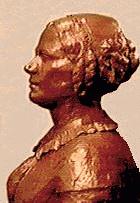|
You are viewing ARCHIVED content published online before January 20, 2025.
Please note that this content is NOT UPDATED, and links may not work. For current information,
visit https://www.nps.gov/aboutus/news/index.htm.
Contact: Lee Werst, 315.568.5302

NPS As part of it’s observance of Women’s History Month, Women’s Rights National Historical Park will unveil a new exhibit in the park’s visitor center on Saturday, March 7. "Catharine Blaine: Seneca Falls and the Women’s Rights Movement in Washington State" tells the story of this signer of the Declaration of Sentiments at the First Women’s Rights Convention in Seneca Falls in 1848. Catharine Paine married Rev. David E. Blaine of Varick, N.Y. in 1853. They served as the first Methodist missionaries to the new community of Seattle, Washington Territory, between 1854 and 1856. As Seattle’s first school teacher, Blaine brought ideas of woman suffrage to the new territory. The exhibit was funded by the National Park Service Challenge Cost Share Program in cooperation with Washington State Historical Society. The exhibit will be on display at the Women’s Rights National Historical Park visitor center, 136 Fall Street, Seneca Falls. The Elizabeth Cady Stanton House will begin a new season with an open house on March 7 and 8, 10:00 a.m. to 4:00 p.m. each day. Located at 32 Washington Street in Seneca Falls, the house is part of Women’s Rights National Historical Park. Beginning March 9 the house will be open by ranger led tour only at 11:15 a.m. and 2:15 p.m. daily. The house was the home of Elizabeth Cady Stanton, one of the organizers of the First Women’s Rights Convention held in 1848, in Seneca Falls. After the convention Stanton was recognized as one of the leaders of the women’s rights movement in the United States. In 1869, Stanton, along with Susan B. Anthony, formed the National Woman Suffrage Association (NWSA). The organization pushed for a woman’s suffrage amendment to the United States Constitution. The Elizabeth Cady Stanton House has been restored to its 1848 appearance and is listed as a National Historic Landmark. For more information call Women’s Rights National Historical Park at 315-568-0024. |
Last updated: February 26, 2015
